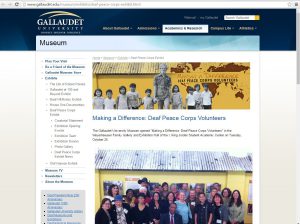Whether sharing tales of overcoming the challenges, adjusting to a new culture, or the humor found in daily adventures, Returned Peace Corps Volunteers each possess invaluable stories about the places they lived and worked. Adventure, challenge, and personal connections built across cultural boundaries provide the basis of volunteers’ memoirs and narratives. Regardless of where they served, each story serves as a way to educate Americans about the rest of the world.
In addition to what’s available in the Peace Corps Community Archive, check out the library’s growing collection of Peace Corps memoirs. This list is far from exhaustive, but includes some of the best memoirs on the shelf. Browse the shelves for other great reads.
 Beyond Siberia: Two Years in a Forgotten Place by Sharon Dirlam
Beyond Siberia: Two Years in a Forgotten Place by Sharon Dirlam
Based on a collection of journals written during their time abroad, Sharon Dirlam presents the story of her and her husband’s work as Peace Corps Volunteers in Birobidjan. Serving in a Jewish Autonomous Region of Russia, removed from most foreigners, the volunteers learned about native Russians and their culture in a unique way.
 From Microsoft to Malawi: Learning on the Front Lines as a Peace Corps Volunteer by Michael L. Buckler
From Microsoft to Malawi: Learning on the Front Lines as a Peace Corps Volunteer by Michael L. Buckler
Buckler’s memoir, inspired by his journals, depicts his yearning to serve after divorcing and completely changing career paths. The narrative recounts the fruitful collaboration between volunteers and locals in order to make significant changes within the community.
 South of the Frontera: A Peace Corps Memoir by Lawrence F. Lihosit
South of the Frontera: A Peace Corps Memoir by Lawrence F. Lihosit
Lihosit narrates a story about joining the Peace Corps after losing his job, which led him to meet the woman he would eventually marry. In addition to providing a sense of adventure, he presents the professional and personal challenges of living, working, and traveling throughout Mexico and Honduras during the 1970s.
T he Unheard: A Memoir of Deafness and Africa by Josh Swiller
he Unheard: A Memoir of Deafness and Africa by Josh Swiller
The Unheard presents a different perspective on the Peace Corps experience. Josh Swiller attempted to act normal and fit in despite being deaf. He joined the Peace Corps to experience a new opportunity. His memoir recounts the daily events, as well as his work at a local health clinic. This story provides insight into the challenges and rewards of serving in the Peace Corps with a disability.
 Other books in the library’s possession include collections of stories from Returned Peace Corps Volunteers. Varying from region of the world and type of work, the stories reflect on past experiences abroad. Going Up Country includes writers who return to the country of service to document the nation’s growth, change, and what any visitor should know about the place. Tales from Colombia presents the perspectives of the earliest Peace Corps volunteers to Colombia called to action by President Kennedy’s charge. Humor evades the stories, ranging from around the world, included in The Funniest Job You’ll Ever Love.
Other books in the library’s possession include collections of stories from Returned Peace Corps Volunteers. Varying from region of the world and type of work, the stories reflect on past experiences abroad. Going Up Country includes writers who return to the country of service to document the nation’s growth, change, and what any visitor should know about the place. Tales from Colombia presents the perspectives of the earliest Peace Corps volunteers to Colombia called to action by President Kennedy’s charge. Humor evades the stories, ranging from around the world, included in The Funniest Job You’ll Ever Love.
Additional Suggestions:
- A Land Without Time: A Peace Corps Volunteer in Afghanistan, by John Sumser
- Even the Smallest Crab Has Teeth: 50 Years of Amazing Peace Corps Stories, edited by Jane Albritton
- Going Up Country: Travel Essays by Peace Corps Writers, edited by John Coyne
- Power Lines: Two Years on South Africa’s Borders, by Jason Carter
- Tales from Colombia: The Deeds and Misdeeds of 41 Peace Corps Volunteers Who Answered President Kennedy’s Call to Serve, by Gary Dean Peterson
- Tarnished Ivory: Reflections on Peace Corps and Beyond, by Peter Bourque
- The Funniest Job You’ll Ever Love: An Anthology of Peace Corps Humor, edited by Lelah Conrad




























